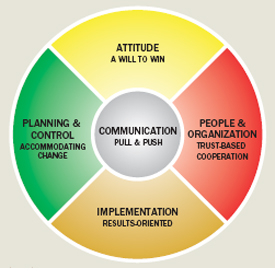By Dr. Alexander Laufer
This summer, the Knowledge Sharing Initiative will be celebrating its fifth birthday
For almost twenty years, the main thrust of my research has been to gain an understanding of the elements that make for successful project management. Since I wanted to develop a “theory of practice,” most of my research was based on first-hand data. I started by identifying the most competent project managers, interviewing them, observing them in action, and listening carefully to their stories.
This has indeed been a long and arduous voyage, since it was not always smooth sailing. Several times I reached the painful conclusion that in order to make any progress, I would first have to unlearn long-held concepts. In the end came the satisfaction, as I was able to formulate a set of principles that could deal head-on with the current dynamic environment of project management.
Readers of ASK will recall that I shared three of these unlearning experiences in my columns in ASK 12, 13 and 16. I also discussed several milestones in my research, as well as some of my findings in ASK 1, 4, 7 and 18. (See to Dr. Laufer’s previous articles.) In this column, I present a brief summary of my findings which have been reduced to five major principles.* ASK is one of the primary products of the Knowledge Sharing Initiative (KSI) of the NASA Academy of Program and Project Leadership (APPL). KSI broke ground following the first Forum of Master Project Managers that was held in July 1999 in Leesburg, VA. The keynote speaker in that Forum was the NASA Administrator, Mr. Daniel Goldin.
Therefore, this summer KSI will be celebrating its fifth birthday. I join in this celebration by presenting my current understanding of the five principles of project management in a dynamic environment, linked to 30 stories which were published in previous issues of ASK. Each principle is supported by three sub-principles and each of these, in turn, is linked to two stories from ASK, in which the sub-principle is demonstrated. By reviewing the principles and the stories together, I believe the reader will gain a deeper appreciation of the principles, as well as their application to project management in a dynamic environment.
The following two-colored figures should help the reader gain a better understanding of the principles. The first, “Results-Focused Leadership — Essence of the Principles,” that graphically and most succinctly describes each of the principles, should help the reader see them as a single entity. The second, “Results-Focused Leadership — The Human Metaphor,” shows how we, as human beings, resort to many different yet complementary resources in our lives. It should help the reader to better understand the unique nature of each of the five principles, as well as their mutual interdependence.
The colors were selected to reflect some of the unique characteristics of the principles.
Green (vegetation and growth) for planning: suggests the growing, learning-based and evolving nature of project planning and control in a dynamic environment.
Yellow (sunshine and optimism) for attitude: suggests the spirited nature of the required “will to win” leadership.
Brown (earth) for results-oriented implementation: suggests the down-to-earth, practical, results-based focus.
Red (heart) for people and organization: suggests the softer aspects of people and teams, in particular, feelings, emotions, and warm and trusting relationships.
Gray (drab, fog) for communication: suggests the endless, ongoing, non-heroic and tedious efforts required for project communication. (It also represents the nebulous ambiguity resulting from continuous irrelevant and unclear information — a problem that frequent, intensive, and rich communication may help resolve.)
The Five Principles of Managing Projects in a Dynamic Environment
Consider these five principles as a single entity composed of five complementary and interconnected sets of activities, each balancing the other.
- Implementation of any one principle and its impact on project success depends on the implementation of all the others. To compensate for inability to fully adhere to a principle, be prepared to modify the implementation of the others as well as adjust project expectations.
- Embrace and apply these principles as general guidelines that must be tailored to each unique context of the project (e.g., stability of objectives, speed, task’s complexity, organizational culture, top management support, team members’ experience and skills).**
PLANNING & CONTROL
- Plan and Control to Accommodate Change
- Adopt a learning-based planning mind-set: start by defining project objectives that are dictated by customer’s needs, however, don’t finalize them before you quickly explore the means and the solutions.
Lessons from the Great Masters, ASK 3
The One Thing You Need to Know, ASK 6
- Start planning early and employ an evolving planning and control process: continuously and throughout project life collect feedback on changes in the environment and in planning assumptions, and on project performance.
Check Your Ego at the Door, Please, ASK 4
Implementation Reviews, ASK 12
- Use an appropriate amount of redundancy to contain the impact of uncertainty and enhance the stability of the plan: add reserves; loosen the connections between uncertain tasks; prepare contingency plans for extremely uncertain and crucial tasks.
A Good Man is Hard to Find, ASK 15
Checkmate to Uncertainty, ASK 17
IMPLEMENTATION
- Create a Results-Oriented Focus
- Create and maintain a focus; decide what NOT to do.
How to Say No, ASK 1
Enough Is Enough, ASK 14
- Right from the beginning and throughout, focus on results — both long-term and short-term. In particular, prepare tangible intermediate products (e.g., prototypes) that provide you rich and quick feedback and that the customer can easily understand and assess.
Dropping in on Mars, ASK 13
Proof of Concept, ASK 13
- Develop a pragmatic mode of operation: invest in planning yet be ready to respond swiftly to frequent, unanticipated events; identify areas where the search for optimal solutions is worthwhile, but for the rest of the project, be ready to embrace “good enough” solutions; for repetitive activities or critical areas (i.e., safety), employ formal/standard work processes, otherwise, employ those that are informal or ad hoc.
Simplify and Succeed, ASK 9
Thanksgiving Hocus Pocus, ASK 10
ATTITUDE
- Develop a Will to Win
- Develop a sense of a mission and “own” the project. (When needed, engage in politics and work hard to sell your project).
Know Thyself — But Don’t Forget to Learn About the Customer Too, ASK 5
Stumping for the Project, ASK 12
- When necessary, challenge the status quo and be willing to take calculated risks.
Listening to the Voice Inside, ASK 2
What GOES Around, Comes Around, ASK 16
- Persevere; keep trying until you get it right. Yet, know when it is time to change course or retreat.
Marbles for the Imagination, ASK 16
The Don Quixote Complex, ASK 5
PEOPLE & ORGANIZATION
- Collaborate through Interdependence and Trust
- Take recruiting very seriously and spend as much energy as possible on getting the right people.
The Idyllic Workplace, ASK 7
Start-Up, ASK 11
- Develop trust-based teamwork and make sure that team members feel dependent upon each other and share the conviction that they are mutually responsible for project results.
Chaos Is the Fraternal Twin of Creativity, ASK 3
Earthly Considerations, ASK 12
- Throughout project life, assess team functioning, ensure its alignment on project objectives, and renew its energy.
Keeping the Deal, ASK 7
The Journey Back, ASK 16
COMMUNICATION
- Pull and Push Information Intensively
- Frequently and vigorously pull and push (ask for and provide) information within and across functions and teams, including all project stakeholders.
Open Newsletters, ASK 6
What Has He Done for Me Lately?, ASK 9
- Employ multiple communication mediums; in particular, extensive frequent face-to-face communication and modern information technology.
The Join-Up Meeting, ASK 7
Say What You Mean, ASK 16
- Adopt a moving about mode of communication. (Moving about helps you affect project performance by better understanding what is going on and by influencing people’s behavior in a timely, natural, and subtle way.)
A Gentle Touch, ASK 9
Walking a Fine Line, ASK 17
*My 1996 book,
Simultaneous Management, fully addresses principles 1, 4 and 5, and only partially principles 2 and 3. The book I co-authored with Ed Hoffman in 2000,
Project Management Success Stories, goes further by addressing fully the third principle, but still addressed the second principle only partially. A later reexamination of the data presented in both books showed that ALL five principles are fully substantiated by the data. Reexamining the findings was triggered primarily by my work with NASA’s project managers in 1999-2000 (in the early stages of the KSI). A more recent research composed of four case studies (two from NASA and two from the USAF), also support all five principles. These four case studies will be published soon in a book co-authored by A. Laufer, T. Post and E. Hoffman.
**Project context affects the manner in which a principle is implemented as well as the extent to which a principle must or can be implemented. For example, when organizational culture does not foster trust-based teamwork, you must rely more on formal work processes rather than informal ones. Or, when project environment is stable and task novelty low, there is less need to adopt an evolving, learning-based, planning process, and it is more appropriate to employ the traditional planning process that freezes project objectives and scope early on.
More Articles…
by Dr. Alexander Laufer
- Letter from the Editor-in-Chief — Shared Voyage: Encouraging Unlearning
(ASK 21) PDF
- Letter from the Editor — A Tale of Two Houses: Building on a Foundation of Trust or Mistrust
(ASK 20) PDF
- Letter from the Editor — Managing Projects in a Dynamic Environment
(ASK 19) PDF
- Letter from the Editor — Looking Ahead with Anticipation
(ASK 18) PDF
- Letter from the Editor — Checkmate to Uncertainty
(ASK 17) PDF









